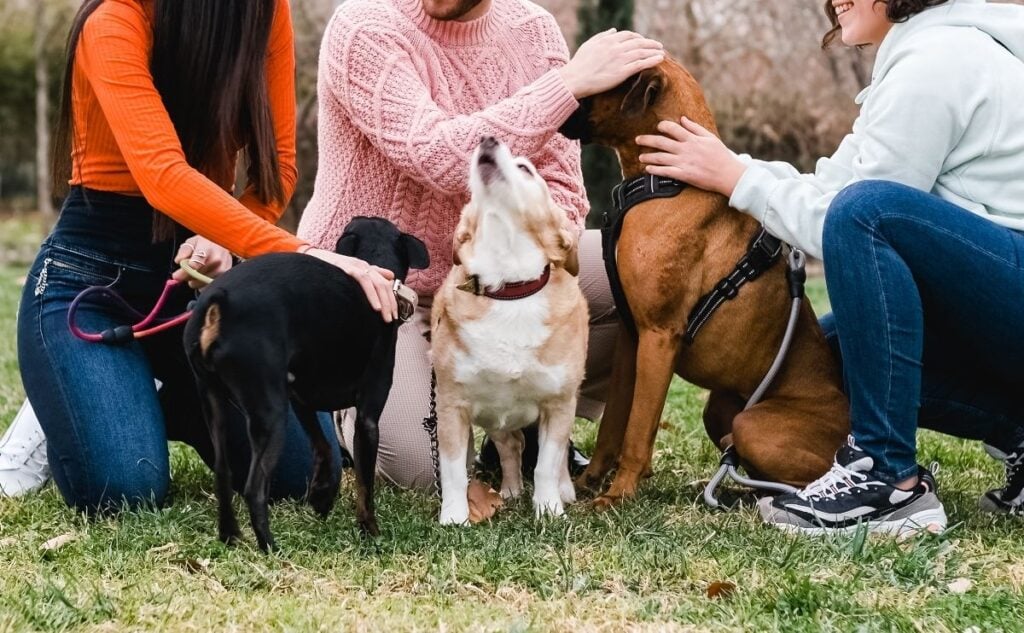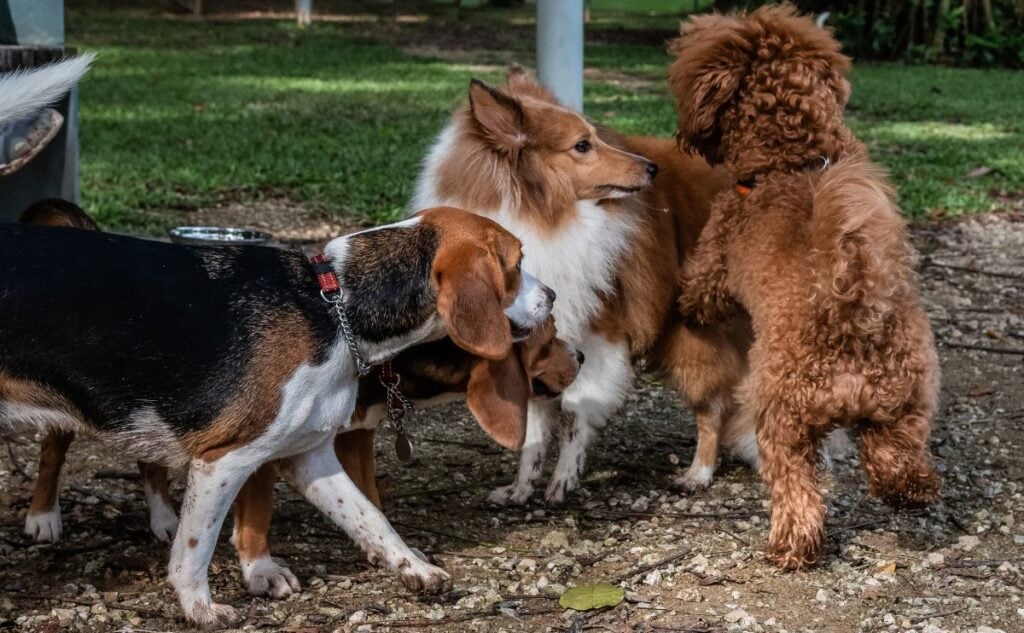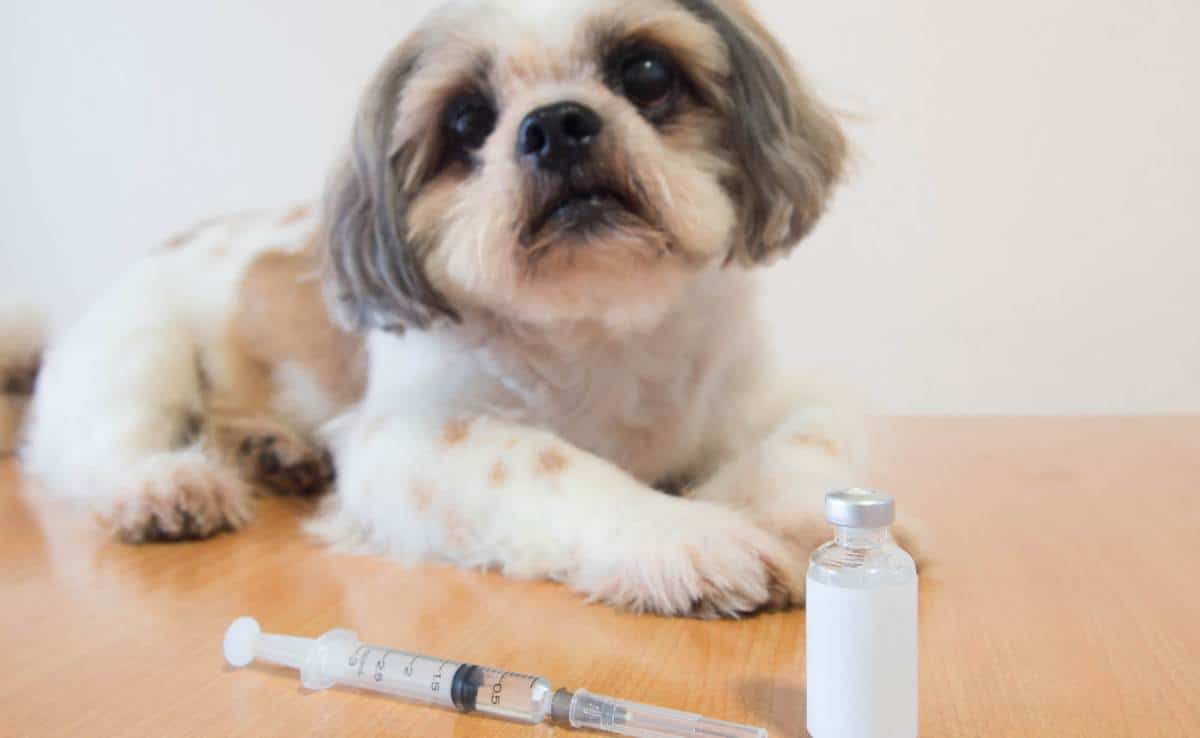New Puppy? You’ve Got 12 Weeks To Get Puppy Socialization Right
When you purchase through links on our site, we may earn a commission. Here’s how it works.
Your puppy’s brain is on a timer. And if you miss the next few weeks, you might raise a dog who’s terrified of… balloons, beards, your mailman, or all three, and more!
Table of Contents
It’s called the “socialization window,” and it’s closing fast, usually around 12 weeks old. That’s when science says your pup decides what’s safe and scary and whether your vacuum is a friend or a monster.
Don’t worry. This isn’t about obedience school. It’s about real-life stuff that turns your cute new pup into a calm, confident dog. And it only takes a few minutes a day.

The catch? You’ve got a deadline, and it starts now. So, where do you start? What do you need to know? I answer all your questions about how to socialize your puppy so they grow up to be a secure social butterfly.
When To Socialize A Puppy: The Magic Window
You’ve got a short, critical window to shape your puppy’s world, and it starts earlier than most people think.
After about four months, introducing puppies to new situations becomes much more challenging. What your puppy doesn’t experience now might scare them for life.
Understanding The Puppy Socialization Period & The Science Behind It
Science says that the magic socialization period is from 3 to 12 weeks old. This is called the critical socialization period. During this window, puppies are forming their lifelong blueprint for what’s normal, safe, and friendly.
This is when your puppy’s brain is like a sponge, deciding what’s safe, normal, and totally not a threat (like skateboards or doorbells).
Why This Matters
- Puppies are neurologically primed to accept new experiences during this phase
- Anything not encountered may be treated as scary or threatening later
- This period affects not just behavior but emotional resilience for life
According to the American Veterinary Society of Animal Behavior (AVSAB), the risk of under-socializing outweighs the risk of disease in most controlled environments. That’s why early, safe, positive socialization is considered more important than waiting until your puppy is “fully vaccinated” before starting. More on this later.
What The Research Shows
- A landmark study by Drs. Scott and Fuller, in the 1960s, found that puppies not exposed to humans before 14 weeks struggled to form normal social bonds.
- Research conducted by Appleby et al. confirmed that early, varied social exposure led to fewer behavior problems in adulthood.
- Further research states that under-socialized dogs are far more likely to be surrendered due to preventable behavior issues.
In short, this isn’t just about having a friendly dog. It’s about shaping your pup’s emotional stability for life.
So When Should You Start Socializing A Puppy?
- Start at 3–4 weeks if you’re a breeder or foster
- Get serious by 6–8 weeks if you’re a new puppy owner
- Don’t delay past 12 weeks because that’s when fears and reactivity can start to form
You don’t need formal training yet. You just need safe, positive exposure to new people, places, sounds, and textures.
Quick Win: Carry your pup around busy areas, let them watch the world, and offer treats whenever they see something new.
Not Fully Vaccinated? You Still Need To Socialize Your Puppy
But how do you socialize your puppy when they are not fully vaccinated yet to protect against disease and parasites? With caution, say experts.
Most puppies don’t get all of their vaccines until at least 16 weeks old. So, you have to be careful when you’re introducing your pup to older dogs and outdoor experiences. Stick to controlled, low-risk environments, like your home, your yard, or visits with fully vaccinated dogs you trust.
Although puppies can contract diseases by picking up small amounts of excrement left behind by sick dogs in public places, the American Veterinary Medical Association (AVMA) states that dog behavior problems from lack of puppy socialization are of greater concern than the chance of contracting a disease in a public place.
What Happens If You Skip Puppy Socialization?
If your puppy doesn’t learn to feel safe around everyday things now, they’re more likely to fear them later. That could mean a dog who trembles at trash cans, lunges at joggers, or panics during vet visits.
The last thing you want is for your pup to end up scared of their own shadow their whole life. The world can be a series of overwhelming and frightening experiences for an unsocialized dog.
Socializing a puppy is much more than just introducing them to people and other dogs. It also involves getting your puppy comfortable with new sights, sounds, smells, other animals, and new environments. If not properly socialized, dogs tend to face new people, other pets, loud noises, and other sensory triggers with fear, anxiety, and even aggression.

Common Consequences Of Skipping Early Socialization
- Fear of strangers, kids, noises, or new places
- Leash reactivity or aggression toward other dogs
- Chronic anxiety, barking, or destructive behavior
- Stressful grooming and vet experiences for life
You don’t just “miss out” on socialization. You pay for it with long-term stress (and sometimes higher vet bills). But if you’ve exposed your puppy to a wide variety of situations, they are much more likely to grow into a secure, happy, and relaxed family pet.
And here’s the kicker: many dogs in shelters and rehoming situations ended up there because they weren’t socialized properly as puppies.
The Good News?
You can prevent most of this with just a few minutes of gentle, guided exposure every day, starting right now.
Socializing Puppies: The ‘Expose But Don’t Overwhelm’ Rule
Think of socialization like seasoning food: a little goes a long way, and too much at once can ruin the experience. The goal isn’t to flood your puppy with new things. It’s to introduce them to life in small, safe, positive doses.
Here’s how to do it right:
- Start slow: One new experience at a time, like a loud noise, a person in a hoodie, or a gentle touch from a stranger
- Watch their body language: Are they curious or cowering?
- Always pair new things with rewards: Treats, praise, or play
Pro Tip: If your pup seems nervous, don’t push through it. Pause, back off, and try again later. This builds trust.
Do This…
- Carry your pup to a quiet café patio
- Let them sniff a wheelchair or umbrella
- Introduce them to one friendly, vaccinated adult dog
Not This…
- Drag them through a busy farmer’s market
- Drop them into a chaotic dog park
- Force interactions when they’re scared or shut down
Remember, socialization should feel like gentle curiosity, not survival training. Overwhelm your pup, and you could scare them for life.
What’s The Best Way To Socialize Your Puppy?
There are many ways to expose your puppy to new people and dogs while minimizing the risks of harming any party.
How To Socialize A Puppy With People (Even The Weird Ones)
Puppies don’t just need to meet people. They need to meet all kinds of people. Hats, beards, wheelchairs, sunglasses, deep voices, high voices, and kids on scooters.
Introducing your puppy to a variety of people helps them become well-adjusted adults. Understanding why dogs may react negatively toward certain individuals can provide insight into the importance of early socialization.
If your puppy only meets calm adults in quiet rooms, they might panic the first time they see Uncle Gary with his booming laugh and fishing vest. Here’s your game plan…
Invite People Over To Your Home
Spending too much time with just a few household members can lead to overprotectiveness and even separation anxiety when you leave.
Getting your dog used to accepting visitors into its home is crucial to a healthy demeanor. This applies to both visitors and family members. Let them give your puppy treats to create a positive association.
Choose people who know how to interact with puppies. A huge part of socializing a puppy is getting them comfortable being handled and cuddled by several different people. Still, it would help if you exposed them to people who understand careful dog handling.
It is also important to ask guests to remove their shoes before entering your house. This will prevent any exposure to potentially harmful particles on shoes (puppies may not have a fully developed immune system yet).
Expose Your Puppy To Different People
If possible, it’s best to introduce your puppy to various people daily. Choose family and friends of different genders, ages, and races so your puppy gets used to the society they’ll encounter in their world.
Expose your pup to different clothing, too. Think tall people, loud talkers, people in uniforms, sunglasses, hoods, backpacks, and helmets.
How To Safely Socialize Your Puppy With Other Dogs
Dogs are social animals, and if you’ve owned a dog before, you know how much they gravitate to other dogs. As part of the socialization process, it’s vital to introduce your young puppy to other dogs during their formative time so they don’t develop anxious, fearful, or aggressive behavior toward their fellow canines.
But dog-to-dog socialization isn’t a free-for-all at the dog park. It should be a carefully managed intro, especially during your puppy’s early weeks.
Done right, it helps your puppy learn how to play politely, read signals, and stay calm around other dogs. Done wrong, it can set back their progress fast.
Choose The Right Dogs & Settings For Intros
- Fully vaccinated and calm (avoid overly hyper or dominant dogs)
- Well-socialized adults are better than excited puppies
- Keep the first meetups short and on neutral ground (not inside the home)
- Go for a short sniff-and-walk with a well-known, friendly dog
- Practice parallel walks with some distance at first
- Reward calmness and respectful greetings with treats
Watch for body language and healthy play cues. Bouncy movement, play bows, pausing, and tail wagging are great signs. Stiff posture or hard staring? It’s time to get out.
Avoid This…
- Crowded or chaotic dog parks
- Letting your pup “figure it out” with unknown dogs
- Off-leash chaos if you’re unsure how the other dog will respond

Dog socialization doesn’t mean “meet every dog you see.” It means learning how to be near other dogs without panic, barking, or bad habits.
What About Dog Parks?
Although some experts say it’s a great way to socialize your puppy, you’re taking a considerable risk with dogs you don’t know. It’s best to wait until your puppy is a bit older and has all their vaccinations before venturing to the dog park.
What About Puppy Socialization Classes?
Dog behaviorists strongly recommend enrolling in a puppy training class. These classes are a safer choice than taking your puppy to a dog park because there’s less risk that the other puppies in the class carry diseases. Pick a reputable puppy class and trainer with experience.
Not only will your pup get the socialization needed, but they’ll also pick up some crucial behavioral training at the same time. You might also try online dog training as an at-home option, especially as they get a little older.
How To Read Your Puppy’s Body Language During Socialization
Your puppy may not speak, but they’re constantly communicating. And during socialization, those signals tell you whether you’re on the right track or pushing too far.
Learning to read your pup’s body language helps you adjust in real-time so experiences stay safe and positive.
Signs Your Puppy Is Comfortable
- Loose, wiggly body
- Curious sniffing
- Tail wagging at mid-height
- Play bows or a gentle approach
- Willingly takes treats or engages with you
Signs Your Puppy Is Overwhelmed
- Tail tucked or body stiff
- Yawning (not sleepy), lip licking, or shaking off
- Backing away or hiding
- Refusing treats
- Sudden barking or freezing
If you see stress signs, end the session calmly and try again later with a softer approach. Pushing through can create fear instead of confidence.
Puppy socialization is like filling a trust bank. You want lots of small, positive deposits, not big withdrawals that break their confidence.
What To Avoid In Puppy Socialization: Important Recap
Even with the best intentions, it’s easy to overdo or misstep during socialization. Not all puppy socialization is productive. Depending on their personality, some puppies will be more skittish in new situations, so be careful to watch your pup’s cues.
These common mistakes can set your puppy back or worse, cause lasting fear or anxiety. So, let’s make sure that doesn’t happen.
Don’t Wait For All Vaccines
It’s a myth that you must keep your puppy in total isolation until 16 weeks. Safe, controlled exposure is far better than total lockdown. The risk of behavior problems from under-socialization is greater than the risk of disease in most clean environments.

Don’t Force Interactions
If your puppy seems scared, don’t shove them toward a stranger or let a dog rush them. That teaches fear, not confidence. Always let your pup choose to engage.
Don’t Start At The Dog Park
Dog parks are chaotic and unpredictable. You don’t know the other dogs’ health, training, or behavior. Wait until your dog has solid social skills before entering high-energy zones.
Don’t Skip Recovery Time
Socialization isn’t a marathon. Overloading your puppy with five big and new experiences in a day can cause burnout. Give them time to rest, process, and feel safe.
Don’t Reward Fear
Don’t reward your puppy if they’re showing fear. This is a tough one because we want to soothe our fur babies. But you don’t want your puppy to end up thinking fearful behavior is worthy of praise. They need to work through their apprehension.
Bottom Line: Go at your puppy’s pace. Slow and steady builds trust, which is the foundation of a well-adjusted adult dog.
Puppyhood Is The Best Time To Consider Pet Insurance
As a puppy, your dog has probably not shown any significant health concerns at their young age. Since pet insurance companies do not cover pre-existing conditions, the younger your dog is when you sign up, the better coverage you will likely receive throughout their lifetime.

Further, pet insurance can help support you financially during the unpredictable puppy years when dogs are more likely to chew on things they shouldn’t and run into dangerous situations. Check out our pet insurance 101 guide to learn more and determine whether pet insurance is worth it for your puppy.
More Tips For Socializing Your Puppy
Check out this entertaining video we made with some additional tips (and a slew of adorable puppies to boot)!
A Final Reminder: Don’t Wait To Start!
It’s your responsibility as a new puppy parent to steer your pup in the right direction and make sure he or she grows up to be a content, well-behaved, and anxiety-free dog. Understanding puppy fear periods can also help you socialize your pup more effectively by recognizing when they’re especially sensitive or prone to developing fears.
Don’t miss your small window of opportunity during your puppy’s formative time. Once this window is gone, you have missed your best chance.
Frequently Asked Questions About Puppy Socialization
Even experienced dog owners have questions about socialization, especially when it comes to timing and safety. Here are the answers new puppy parents really need. If you have a question we’ve missed, ask us in the comments, and we’ll find the answer for you.
Can I Socialize My Puppy Before They’re Fully Vaccinated?
Yes, with precautions. Stick to safe areas like your home and yard or calm indoor visits with vaccinated and friendly dogs. Avoid dog parks and pet store floors. The AVMA says behavior problems from under-socializing are often more dangerous than disease risk in controlled settings.
Is It Too Late To Socialize My 6-Month-Old Puppy?
Not at all, but it may take more time and patience. Use slow exposure, positive reinforcement, and possibly work with a dog trainer if they show fear or reactivity.
I Live in An Apartment. How Can I Socialize My Puppy?
You’ve got options! Use elevators, stairwells, balconies, sidewalks, and invite friends over wearing different clothes. Play recorded noises and let your pup observe the world from a safe spot. Your pup still needs to get outside and explore the world, so don’t let where you live limit you and your pup.
How Many New Experiences Should My Puppy Have Per Day?
Aim for 1–3 short, positive exposures daily. Think quality over quantity. A calm greeting from a person is better than five overwhelming new situations at once.
Is Crate Training Part Of Socialization?
Yes! Crate training is a powerful tool in your socialization toolkit. It teaches your puppy to feel safe and secure in a controlled space, which helps reduce anxiety during travel, vet visits, or time alone.
A well-socialized puppy should be comfortable being crated at home and in new environments. Introduce the crate gradually with treats and praise so it becomes a cozy, positive place and not a punishment.
How Do I Socialize My Puppy To Car Rides?
Car rides can be scary for puppies, and some may even experience motion sickness. Early training and encouragement are key because this isn’t something they’re naturally used to.
Start with short, positive rides and gradually increase the duration. Use treats and calm praise to build a good association. Over time, teach your puppy to tolerate seat belts or dog car seats, which are essential for safety. Helping your pup enjoy car travel opens the door to a lifetime of adventures together.
Level Up Your Puppy Parenting: What’s Next?
Want more puppy advice? Check out our new puppy checklist, a puppy housebreaking guide, an expected puppy vaccine schedule, and instructions on how to puppy-proof your home.
Got a socialization win (or fail)? Share your puppy stories in the comments. We’d love to hear what worked, what didn’t, and how your pup is adjusting to the big, wide world. Your experience might help another new dog parent!



